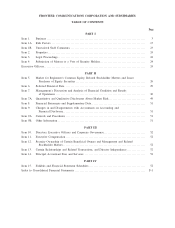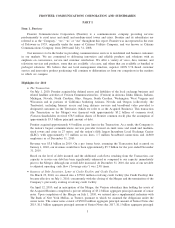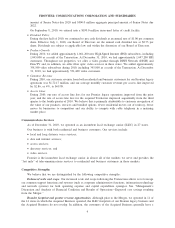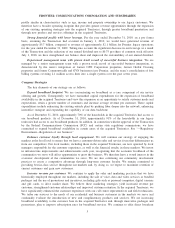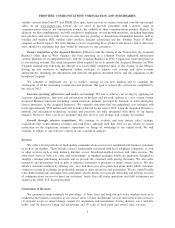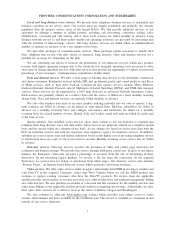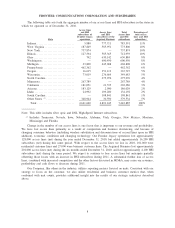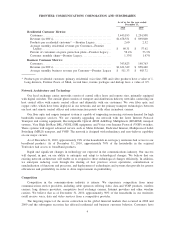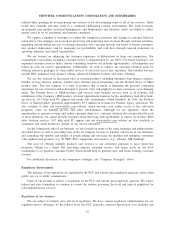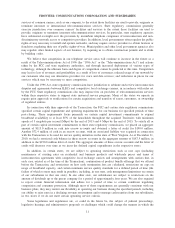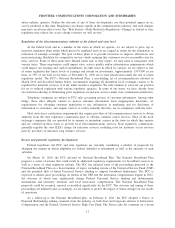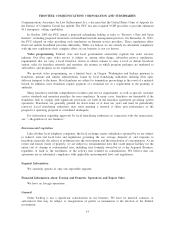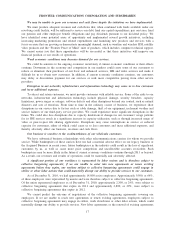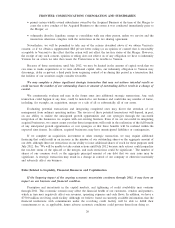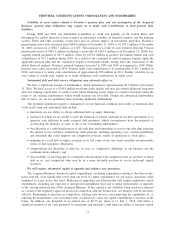Frontier Communications 2010 Annual Report Download - page 13
Download and view the complete annual report
Please find page 13 of the 2010 Frontier Communications annual report below. You can navigate through the pages in the report by either clicking on the pages listed below, or by using the keyword search tool below to find specific information within the annual report.entire industry operates. Neither the outcome of any of these developments, nor their potential impact on us,
can be predicted at this time. Regulation can change rapidly in the communications industry, and such changes
may have an adverse effect on us. See “Risk Factors—Risks Related to Regulation—Changes in federal or state
regulation may reduce the access charge revenues we will receive.”
Regulation of the telecommunications industry at the federal and state level
At the federal level and in a number of the states in which we operate, we are subject to price cap or
incentive regulation plans under which prices for regulated services are capped in return for the elimination or
relaxation of earnings oversight. The goal of these plans is to provide incentives to improve efficiencies and
increased pricing flexibility for competitive services while ensuring that customers receive reasonable rates for
basic services. Some of these plans have limited terms and, as they expire, we may need to renegotiate with
various states. These negotiations could impact rates, service quality and/or infrastructure requirements which
could impact our earnings and capital expenditures. In other states in which we operate, we are subject to rate
of return regulation that limits levels of earnings and returns on investments. Approximately 1,997,000 access
lines, or 35% of our total access lines, at December 31, 2010 are in state jurisdictions under the rate of return
regulatory model. The FCC’s National Broadband Plan, a non-binding set of recommendations released in
March 2010 and described further below, recommends requiring all incumbent local exchange carriers to be
regulated for interstate services, if at all, under incentive regulation. We will continue to advocate our position
for no or reduced regulation with various regulatory agencies. In some of our states, we have already been
successful in reducing or eliminating price regulation on end-user services under state commission jurisdiction.
Telephone companies are subject to FCC rules governing privacy of customer information. Among other
things, these rules obligate carriers to protect customer information from inappropriate disclosure, set
requirements for obtaining customer permission to use information in marketing and for disclosure of
information to customers, and require carriers to certify annually that they are in compliance with the rules.
Most states have certification requirements that require providers of telecommunications services to obtain
authority from the state regulatory commission prior to offering common carrier services. Most of the local
exchange companies that are operated by us operate as incumbent carriers in the states in which they operate
and are certified in those states to provide local telecommunications services. State regulatory commissions
generally regulate the rates ILECs charge for intrastate services, including rates for intrastate access services
paid by providers of intrastate long distance services.
Recent and potential regulatory developments
Federal legislators, the FCC and state regulators are currently considering a number of proposals for
changing the manner in which eligibility for federal subsidies is determined as well as the amounts of such
subsidies.
On March 16, 2010, the FCC released its National Broadband Plan. The National Broadband Plan
proposes a series of actions that could result in additional regulatory requirements for broadband services as
well as a series of other regulatory reforms. The FCC has initiated some of the proceedings proposed in the
National Broadband Plan on a broad number of topics, including reform of the Universal Service Fund (USF)
and the potential shift of future Universal Service funding to support broadband deployment. The FCC is
expected to initiate more proceedings on reform of the USF and the intercarrier compensation regime in 2011,
the outcome of which may significantly change Federal Universal Service funding and disbursement
mechanisms and interstate, intrastate and local intercarrier compensation. The National Broadband Plan
proposals could be accepted, rejected or modified significantly by the FCC. The outcome and timing of these
proceedings are unknown and, accordingly, we are unable to predict the impact of future changes on our results
of operations.
As a follow-up to the National Broadband plan, on February 8, 2011, the FCC adopted a Notice of
Proposed Rulemaking seeking comment from the industry on both short-and long-term reforms to Intercarrier
Compensation and the Federal Universal Service High Cost Fund. The Notice asks for comment on a broad
12
FRONTIER COMMUNICATIONS CORPORATION AND SUBSIDIARIES


